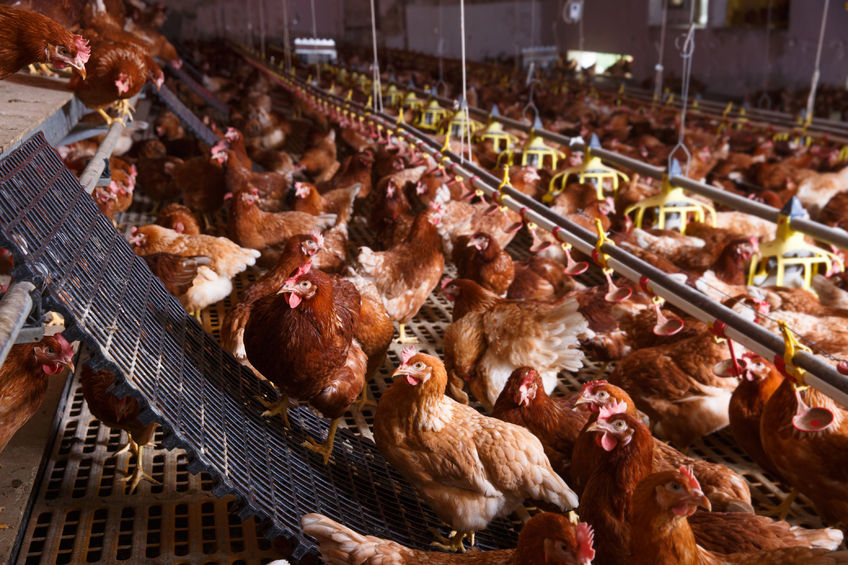
Large farms and high stocking densities bring increased risk of salmonella spread in layer flocks, according to a scientific report for the EU.
The report has been produced by the Scientific Panel on Biological Hazards (BIOHAZ) at the request of the European Commission.
This was in response to an increase in confirmed human salmonellosis cases in the EU since 2014.
Salmonella contamination has been a recurring problem in egg imports from Europe to the United Kingdom.
More than 160 cases of salmonella in the United Kingdom since 2014 were linked to an egg packing centre in Poland. Other outbreaks have been traced to eggs imported from Spain.
In August last year, lawyers confirmed that victims of a salmonella outbreak linked to imported eggs had won thousands of pounds in damages.
A total of 28 people were taken ill after eating at the Real China restaurant in Eastleigh, Hampshire four years ago. The source of the infection was traced back to an egg producer in Germany.
Last autumn the Food Standards Agency (FSA) announced the recall of liquid egg white produced in France following the discovery of salmonella.
The recall, which involved barn farmed liquid egg white sold by fitness food company Dr Zak's, brought a renewed call from Lion for improved safety standards in Europe.
Source British
British Lion has made repeated calls for food manufacturers to play safe by sourcing their egg from domestic producers.
The increased number of cases in the European Union triggered investigations into contributory factors and control options in poultry production.
BIOHAZ was asked by the European Commission to produce a report and the findings have now been published through the European Food Standards Agency (EFSA).
A number of areas of investigation proved inconclusive, but the scientists did find that larger farms and more intensive stocking density could have an adverse impact on salmonella.
"There is conclusive evidence that an increased stocking density, larger farms and stress-inducing conditions result in increased occurrence, persistence and spread of salmonella in laying hen flocks," the panel concluded in its report.
The panel found that the difference in risk between cage and non-cage production systems was less conclusive.
"A review of risk factors for salmonella in laying hens revealed that overall evidence points to a lower occurrence in non-cage compared to cage systems," said the scientists.
However, they added, "A conclusion on the effect of outdoor access or impact of the shift from conventional to enriched cages could not be reached."
'Unenriched eggs'
The scientific panel was asked by the European Commission to review whether the type of farming method used in egg production had any impact on the occurrence of salmonella.
The panel's research was based on monitoring data and a review of literature. In particular, the panel was asked to look into whether the ban on "unenriched cages" had had an effect on occurrence of salmonella.
The panel said in its report: "The presence of salmonella in laying hen flocks housed in different farming systems was compared using data supplied by European Economic Area (EEA) countries following a request from EFSA.
"In addition, a literature review on the influence of housing and management systems, as well as bio-security measures, on salmonella occurrence in laying hens was performed, focusing on recent studies in the EU and equivalent high-income countries.
"Unfortunately, there are no field studies that specifically address the impact of the transition from conventional to enriched cage systems on the occurrence of salmonella in laying flocks.
"It was concluded that conflicting evidence is found in the literature and MS data on the occurrence of salmonella in laying hens when raised in cage systems compared to non-cage systems. Overall, evidence points to a lower occurrence in non-cage systems compared to cage systems.
"Whether this is linked to the housing system as such or whether it is caused by the associated change of furniture, break in the historical infection cycle or the reduced stocking density, is unclear.
"The evidence that outdoor access or conventional versus enriched cage systems affect salmonella occurrence in laying hens at the EU level is inconclusive."
'Conclusive evidence'
Whilst the scientists said that effect of outdoor access was inconclusive, they said that other factors were conclusive.
"There is conclusive evidence that an increased stocking density, larger farms and stress-inducing conditions result in increased occurrence, persistence and spread of salmonella in laying hen flocks."
There was similar evidence on broiler production, they said. "For broiler flocks, the limited evidence available shows that stress, stocking density and increasing the number of flocks per farm increases salmonella susceptibility or infection rate.
"There is no data evaluating the link between welfare indicators and salmonella occurrence in broilers."
The scientific panel has recommended that, in future, monitoring should take place to enable an assessment of whether or not the housing type for laying hen and broiler flocks had any impact on salmonella occurrence.
The scientific panel was also asked to look at whether the current target serotypes listed by the EU should be changed. The panel said that salmonella enteritidis, salmonella typhimurium (including monophasic variants) and salmonella infantis should be retained on the list, while salmonella virchow and salmonella hadar could be replaced by salmonella kentucky and either salmonella heidelberg, salmonella thompson or a variable serovar in national prevalence targets.
However, the scientists said a target that incorporated all serovars was expected to be more effective, as the most relevant serovars in breeding flocks varied between member states and over time.
